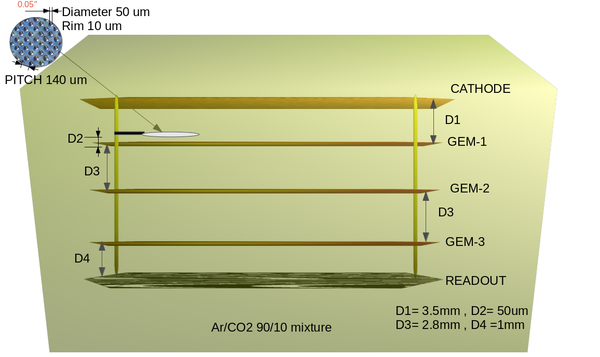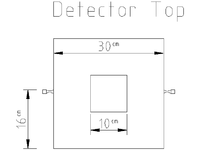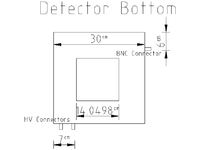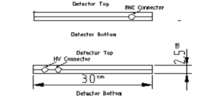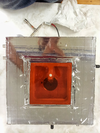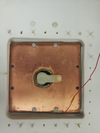Difference between revisions of "Detector Description"
| Line 4: | Line 4: | ||
Detectors are very sensitive devices to the atmosphere particulates. Most of the methods for detector construction and maintaining demand a laminar flow hood or a clean room that accommodates clean environment, Generally, the clean environment are classified depending on the size and number of existing particulates in the room. Also, the clean rooms maintain keeping the number of particulates low by restricting the number of objects that enter the room, in addition to specifying the workers to be clean by provding them with gloves, hats and gowns that are Sdesigned for this purpose. | Detectors are very sensitive devices to the atmosphere particulates. Most of the methods for detector construction and maintaining demand a laminar flow hood or a clean room that accommodates clean environment, Generally, the clean environment are classified depending on the size and number of existing particulates in the room. Also, the clean rooms maintain keeping the number of particulates low by restricting the number of objects that enter the room, in addition to specifying the workers to be clean by provding them with gloves, hats and gowns that are Sdesigned for this purpose. | ||
| + | |||
| + | ==Detector Parts== | ||
The GEM based neutron detector consists of : | The GEM based neutron detector consists of : | ||
Revision as of 18:35, 21 October 2013
GEM Detector Design
Clean Environment
Detectors are very sensitive devices to the atmosphere particulates. Most of the methods for detector construction and maintaining demand a laminar flow hood or a clean room that accommodates clean environment, Generally, the clean environment are classified depending on the size and number of existing particulates in the room. Also, the clean rooms maintain keeping the number of particulates low by restricting the number of objects that enter the room, in addition to specifying the workers to be clean by provding them with gloves, hats and gowns that are Sdesigned for this purpose.
Detector Parts
The GEM based neutron detector consists of :
1- A cathode; a square copper plate has a dimension of 10x10cm and has a distance of 1.2 cm from the top of the fist GEM card. The cathode design allows to raise the potential on its surface up to 5 kV (in air) without any discharge effect.
2- A neutron sensitive material; in our case U-233 have been used as a sensitive material and has relatively a high fission cross in the desired energy range, U-233 is coated on the top of a metal plate in circular disk that has a diameter of 3cm and fixed as a part of the detector cathode's surface.
3- GEM cards; the detector has three GEM cards in square plastic frames, they have dimension of 10x10cm and are placed parallel to the cathode as shown in the figure below.
Insert drawing with dimensions so someone can build a copy of your detector.
Each GEM preamplifier is made of a copper clad kipton plate of a thickness 50 um and an area of 10x10cm, It has holes with a diameter of 50 um and 10 um rim which are chemically etched in an equilateral triangular pattern with 140 um pitch distance.
4- A sealed chamber; All the previous components exist in a chamber that consists of two ertalyte plastic sheets , they are bolted together by a number of M3 plastic screws located around the detector window to form a well closed cavity around the GEM cards away from the surrounding atmosphere. The purpose of sealant is to insulate the chamber's gas from the surrounding atmosphere gas components. Also, the chamber has a square window of kipton of dimension of 13x13cm.
The figures below show top, bottom and side view of the detector design.
Modifying the GEM detector as neutron sensitive detector
The GEM original design is modified to convert it to a neutron sensitive detector. One of changes is in the cathode design, it has a circular coating of U-233 with a diameter of 3 cm and 40-50 um thickness. Also the distance of the cathode from the first GEM becomes 8 mm instead of 3.5 mm. The kepton window's height increased to 2.5 mm, it helps to avoid any direct contact with the cathode when it is located to the new height. The figures below show the modified detector design. An FR4 shutter covers the coating area, if the shutter is close, it will stop the fission fragment ionization, when it is open, the ionization of the fission fragments will be cuase a signal that will be collected by the detector's trigout. The detector trigout is connected to a high pass filter to decrease the level of the detected noise as mentioned in details in the next section.
High voltage divider
GEM preamplifiers are connected with high voltage divider circuit. as shown in the figure below:

The ciruit provides the cathode with the highest voltage to drift most of the electrons primarily produced by ionization, then gradually the voltage decreases to have the least value on the bottom side of the third GEM card, which will help to guide all the electrons to the grounded readout plate.
Go Back [1]
